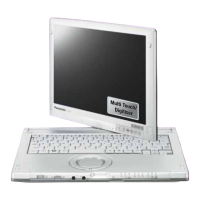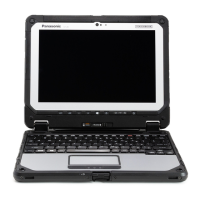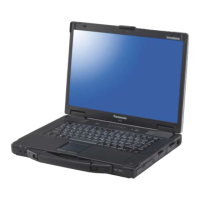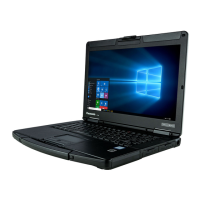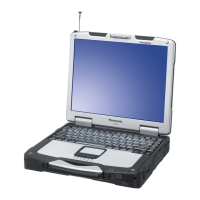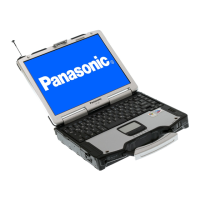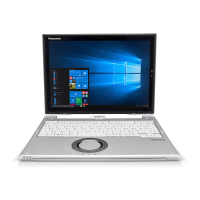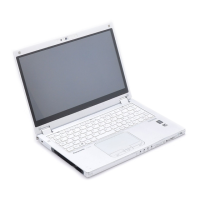Do you have a question about the Panasonic CF-C1 Series and is the answer not in the manual?
Explains issues related to sound and video playback interruptions and solutions.
Details on configuring and using the touchpad utility for scrolling functions.
Instructions for setting up and using the virtual scrolling feature of the touchpad.
Guidelines for proper use, cleaning, and maintenance of the touchpad.
Explains operations using the included digitizer pen for screen interaction.
Describes how to perform operations using touch gestures with your fingers.
Procedure for calibrating the screen for accurate pen and touch input.
Important precautions for handling the computer screen and digitizer pen.
Information on how to configure and customize the functions of the tablet buttons.
Step-by-step guide to reassigning functions to the tablet buttons.
Instructions on how to rotate the computer display orientation.
Details on how to adjust display rotation settings using the Display Rotation Tool.
Using Fn+F1/F2 keys to adjust LCD brightness levels.
Using Fn+F3 key combination to switch display output modes.
Procedure to access and configure hotkey settings for Fn key lock and pop-up icon.
Steps to configure Fn key lock and notification settings for hotkeys.
Instructions on how to launch and use the on-screen software keyboard.
Overview of the software keyboard menu options for customization.
Steps to launch and begin using the hand writing utility.
Procedure to open the main control panel for system operations.
Details on performing various operations via the Dashboard interface.
Information on interpreting battery indicator lights and their meanings.
Methods to check the current battery level and remaining time.
Steps to recalibrate the battery display for accurate readings.
How to enable/disable Economy Mode (ECO) to manage battery life and charging.
Guidance on switching to a specific power plan for energy efficiency.
Overview of available power plans and their default settings for different scenarios.
Step-by-step instructions for changing the computer's power plan.
Details on Panasonic's proprietary power saving features and their settings.
Explains how sleep, standby, and hibernation allow quick resumption of work.
Instructions for configuring sleep, standby, and hibernation settings.
Important warnings and precautions to follow when using sleep/standby or hibernation.
Procedures for entering and resuming the computer from sleep/standby or hibernation.
Guide to setting up supervisor and user passwords for system security.
Methods to secure the computer against unauthorized access using startup passwords.
Instructions on enabling hard disk lock to protect data from unauthorized access.
Information on compatible disc types for reading and writing operations.
Essential precautions for handling the CD/DVD drive and discs.
Details on supported disc formats for reading and writing.
Explanation of DVD-Video region codes and their impact on playback.
Steps for burning files to discs using built-in Windows functionality.
Guide to using Roxio Creator LJB software for CD/DVD recording.
Overview of different DVD-RAM format types and their recommended uses.
Procedure for correctly inserting and removing PC Cards.
Instructions for inserting and removing smart cards from the slot.
Steps for safely inserting and removing SD/SDHC memory cards.
Essential steps to prepare the computer before expanding memory.
Detailed guide on how to install a RAM module into the memory slot.
Instructions for safely removing a RAM module from the computer.
How to change display output modes (e.g., duplicate, extend, projector).
Configuring display settings through the graphics driver properties.
Adjusting screen resolution and output destination via Windows settings.
Setting up and using the extended desktop feature across multiple displays.
Steps for connecting and safely removing USB devices.
Guide to enrolling and authenticating fingerprints with the reader.
Overview of fingerprint authentication technology and its benefits.
Steps for installing the fingerprint reader software and TPM.
Detailed instructions for installing the fingerprint utility and TPM.
Configuring power-on security settings for enhanced system protection.
Options for setting simple or high security modes for fingerprint authentication.
Instructions on backing up fingerprint authentication data for recovery.
Steps to disable power-on security for fingerprint authentication.
Procedure to delete user fingerprint data and associated settings.
Guide to uninstalling the fingerprint security software.
Instructions for connecting the internal modem to a telephone line.
Steps to connect the LAN cable to the computer and network.
Enabling the feature to turn on the computer remotely via LAN.
How to enable or disable the wake-up function for wired LAN connections.
Instructions on using the physical wireless switch to enable/disable communication.
Software utility to control wireless devices and switch functions.
Procedure for installing the Wireless Connection Disable Utility.
Important warnings regarding wireless LAN usage in specific locations.
Steps to turn on wireless LAN communication and connect to networks.
Guide to setting up wireless network profiles for connection.
How to configure wireless LAN standards like IEEE802.11a.
Instructions for enabling and using Bluetooth wireless communication.
Procedure for safely removing and inserting the internal hard disk drive.
How to access and enter the computer's setup utility.
Displays system and product information, including model and serial numbers.
Overview of main configuration settings available in the Setup Utility.
Configuration options for CPU, peripherals, and network settings.
Lists the default boot order for various storage devices.
Instructions on how to modify the boot device sequence.
Settings for password prompts during boot and setup utility access.
Enabling or disabling password protection at system startup.
Procedure to set or change the supervisor password for system access.
Configuration options for fingerprint reader security settings.
Options for saving or loading configuration settings and rebooting.
Allows selection of a boot device for the next startup.
Steps to close applications before using the icon enlargement feature.
Instructions to launch the screen magnification loupe utility.
How to magnify specific parts of the screen using the loupe utility.
Configuration options for loupe window shape, autorun, and shortcut keys.
Troubleshooting common issues with system startup, shutdown, and sleep modes.
Solutions for when the computer fails to enter sleep, standby, or hibernation.
Troubleshooting steps for when Windows fails to shut down properly.
Solutions for issues related to cursor control, movement, and connectivity.
Adjusting screen brightness levels and troubleshooting brightness issues.
Steps to resolve issues where the screen remains blank or black.
Troubleshooting distorted screen display caused by resolution or connection changes.
Resolving issues where letter keys input numbers due to ten-key mode.
Fixing issues where only capital letters are entered due to Caps Lock.
Troubleshooting Fn key combinations that are not functioning correctly.
Resolving issues with digitizer pen accuracy through screen calibration.
Troubleshooting steps for hard disk read/write errors.
Procedure for checking and fixing internal hard disk errors.
Resolving issues preventing the computer from booting from the CD/DVD drive.
Troubleshooting steps for when there is no audio output from the speakers.
Steps to resolve issues with connected peripherals and driver installations.
Lists hardware components that can be diagnosed by the utility.
Procedure for executing hardware diagnostic checks.
How to interpret and act upon the results of hardware diagnostic checks.
Steps to create a backup of the entire hard disk data.
Procedure to restore the entire hard disk data from a backup.
How to access system recovery options for data restoration.
Items required before performing the hard disk data erase utility.
Lists common error messages and their corresponding solutions.
Provides troubleshooting steps for specific error messages.
Steps to configure Intel® AMT for network management and security functions.
Instructions for installing the necessary drivers for Intel® AMT.
Procedure to disable or reset the Intel® AMT configuration settings.
How to launch and use the PC Information Viewer utility.
Steps to save displayed computer usage information to a text file.
Enabling the automatic display of PC Information Popup notifications.
Guidance on hard disk usage, including precautions and notifications.
Customizing display conditions and disabling information popups.
Recommendations for using antivirus software and updating definitions.
Warning against using unverified software and disks.
Guidance on utilizing Windows Firewall for network security.
Importance of Windows Updates for security and system stability.
Information on network software and power saving interactions.
Explains issues related to sound and video playback interruptions and solutions.
Details on configuring and using the touchpad utility for scrolling functions.
Instructions for setting up and using the virtual scrolling feature of the touchpad.
Guidelines for proper use, cleaning, and maintenance of the touchpad.
Explains operations using the included digitizer pen for screen interaction.
Describes how to perform operations using touch gestures with your fingers.
Procedure for calibrating the screen for accurate pen and touch input.
Important precautions for handling the computer screen and digitizer pen.
Information on how to configure and customize the functions of the tablet buttons.
Step-by-step guide to reassigning functions to the tablet buttons.
Instructions on how to rotate the computer display orientation.
Details on how to adjust display rotation settings using the Display Rotation Tool.
Using Fn+F1/F2 keys to adjust LCD brightness levels.
Using Fn+F3 key combination to switch display output modes.
Procedure to access and configure hotkey settings for Fn key lock and pop-up icon.
Steps to configure Fn key lock and notification settings for hotkeys.
Instructions on how to launch and use the on-screen software keyboard.
Overview of the software keyboard menu options for customization.
Steps to launch and begin using the hand writing utility.
Procedure to open the main control panel for system operations.
Details on performing various operations via the Dashboard interface.
Information on interpreting battery indicator lights and their meanings.
Methods to check the current battery level and remaining time.
Steps to recalibrate the battery display for accurate readings.
How to enable/disable Economy Mode (ECO) to manage battery life and charging.
Guidance on switching to a specific power plan for energy efficiency.
Overview of available power plans and their default settings for different scenarios.
Step-by-step instructions for changing the computer's power plan.
Details on Panasonic's proprietary power saving features and their settings.
Explains how sleep, standby, and hibernation allow quick resumption of work.
Instructions for configuring sleep, standby, and hibernation settings.
Important warnings and precautions to follow when using sleep/standby or hibernation.
Procedures for entering and resuming the computer from sleep/standby or hibernation.
Guide to setting up supervisor and user passwords for system security.
Methods to secure the computer against unauthorized access using startup passwords.
Instructions on enabling hard disk lock to protect data from unauthorized access.
Information on compatible disc types for reading and writing operations.
Essential precautions for handling the CD/DVD drive and discs.
Details on supported disc formats for reading and writing.
Explanation of DVD-Video region codes and their impact on playback.
Steps for burning files to discs using built-in Windows functionality.
Guide to using Roxio Creator LJB software for CD/DVD recording.
Overview of different DVD-RAM format types and their recommended uses.
Procedure for correctly inserting and removing PC Cards.
Instructions for inserting and removing smart cards from the slot.
Steps for safely inserting and removing SD/SDHC memory cards.
Essential steps to prepare the computer before expanding memory.
Detailed guide on how to install a RAM module into the memory slot.
Instructions for safely removing a RAM module from the computer.
How to change display output modes (e.g., duplicate, extend, projector).
Configuring display settings through the graphics driver properties.
Adjusting screen resolution and output destination via Windows settings.
Setting up and using the extended desktop feature across multiple displays.
Steps for connecting and safely removing USB devices.
Guide to enrolling and authenticating fingerprints with the reader.
Overview of fingerprint authentication technology and its benefits.
Steps for installing the fingerprint reader software and TPM.
Detailed instructions for installing the fingerprint utility and TPM.
Configuring power-on security settings for enhanced system protection.
Options for setting simple or high security modes for fingerprint authentication.
Instructions on backing up fingerprint authentication data for recovery.
Steps to disable power-on security for fingerprint authentication.
Procedure to delete user fingerprint data and associated settings.
Guide to uninstalling the fingerprint security software.
Instructions for connecting the internal modem to a telephone line.
Steps to connect the LAN cable to the computer and network.
Enabling the feature to turn on the computer remotely via LAN.
How to enable or disable the wake-up function for wired LAN connections.
Instructions on using the physical wireless switch to enable/disable communication.
Software utility to control wireless devices and switch functions.
Procedure for installing the Wireless Connection Disable Utility.
Important warnings regarding wireless LAN usage in specific locations.
Steps to turn on wireless LAN communication and connect to networks.
Guide to setting up wireless network profiles for connection.
How to configure wireless LAN standards like IEEE802.11a.
Instructions for enabling and using Bluetooth wireless communication.
Procedure for safely removing and inserting the internal hard disk drive.
How to access and enter the computer's setup utility.
Displays system and product information, including model and serial numbers.
Overview of main configuration settings available in the Setup Utility.
Configuration options for CPU, peripherals, and network settings.
Lists the default boot order for various storage devices.
Instructions on how to modify the boot device sequence.
Settings for password prompts during boot and setup utility access.
Enabling or disabling password protection at system startup.
Procedure to set or change the supervisor password for system access.
Configuration options for fingerprint reader security settings.
Options for saving or loading configuration settings and rebooting.
Allows selection of a boot device for the next startup.
Steps to close applications before using the icon enlargement feature.
Instructions to launch the screen magnification loupe utility.
How to magnify specific parts of the screen using the loupe utility.
Configuration options for loupe window shape, autorun, and shortcut keys.
Troubleshooting common issues with system startup, shutdown, and sleep modes.
Solutions for when the computer fails to enter sleep, standby, or hibernation.
Troubleshooting steps for when Windows fails to shut down properly.
Solutions for issues related to cursor control, movement, and connectivity.
Adjusting screen brightness levels and troubleshooting brightness issues.
Steps to resolve issues where the screen remains blank or black.
Troubleshooting distorted screen display caused by resolution or connection changes.
Resolving issues where letter keys input numbers due to ten-key mode.
Fixing issues where only capital letters are entered due to Caps Lock.
Troubleshooting Fn key combinations that are not functioning correctly.
Resolving issues with digitizer pen accuracy through screen calibration.
Troubleshooting steps for hard disk read/write errors.
Procedure for checking and fixing internal hard disk errors.
Resolving issues preventing the computer from booting from the CD/DVD drive.
Troubleshooting steps for when there is no audio output from the speakers.
Steps to resolve issues with connected peripherals and driver installations.
Lists hardware components that can be diagnosed by the utility.
Procedure for executing hardware diagnostic checks.
How to interpret and act upon the results of hardware diagnostic checks.
Steps to create a backup of the entire hard disk data.
Procedure to restore the entire hard disk data from a backup.
How to access system recovery options for data restoration.
Items required before performing the hard disk data erase utility.
Lists common error messages and their corresponding solutions.
Provides troubleshooting steps for specific error messages.
Steps to configure Intel® AMT for network management and security functions.
Instructions for installing the necessary drivers for Intel® AMT.
Procedure to disable or reset the Intel® AMT configuration settings.
How to launch and use the PC Information Viewer utility.
Steps to save displayed computer usage information to a text file.
Enabling the automatic display of PC Information Popup notifications.
Guidance on hard disk usage, including precautions and notifications.
Customizing display conditions and disabling information popups.
Recommendations for using antivirus software and updating definitions.
Warning against using unverified software and disks.
Guidance on utilizing Windows Firewall for network security.
Importance of Windows Updates for security and system stability.
Information on network software and power saving interactions.
| Operating System | Windows 7 Professional |
|---|---|
| Processor | Intel Core i5 |
| Storage | SSD |
| Display | 12.1-inch |
| Graphics | Intel HD Graphics |
| Weight | Approx. 1.5 kg |
| Battery | Lithium Ion |
| Wireless | Wi-Fi, Bluetooth |
| Ports | USB, HDMI, VGA, Ethernet, SD card slot |
